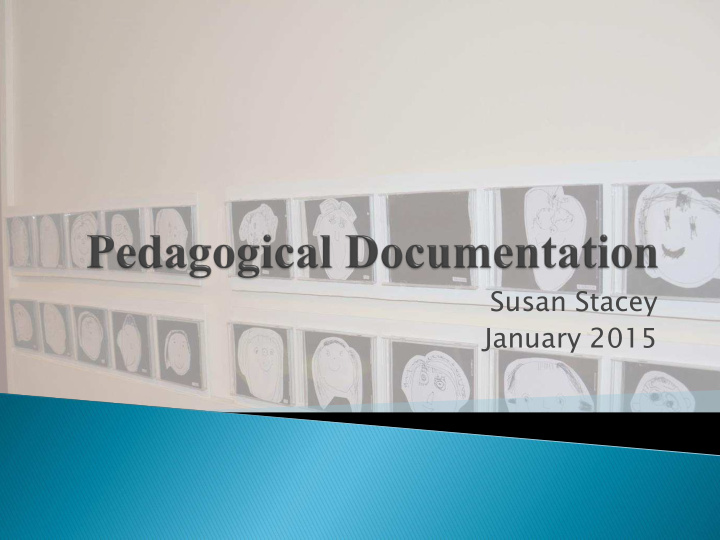



Susan Stacey January 2015
Inspired by the practices of Reggio Emilia, Italy In everyday life, we document in many ways…diaries, social media, keeping records BUT In early years education, pedagogical documentation refers to ‘making thinking and learning visible’ in many ways…using text, transcripts of children’s words (ideas, thoughts), photos of the process, and traces of children’s work. We document in order to share, to understand, and to be understood.
Interesting or puzzling events during play Project – short or long term The process of learning (series of small or large panels) Small, significant moments Developmental milestones Our questions….what do we wonder?
.....it depends! Possibly: Making learning visible Facilitating conversations with parents Revisiting with children; what do they think about their work or the event? Refl flectiv ective process ocess for r teachers chers that t informs forms our r teach chin ing; g; raises aises quest stion ions s for r us and d provi ovides des next t steps ps
Who is the documentation for? (Our audience dictates the content and the vocabulary) Is it for.... Ourselves as teachers? Children? Parents? Other professionals?
Make the decision about wh what you want to document, and wh why How will you document? What form is best suited to this focus? What about design? Things to consider..... o Layout o Font o Pathway for reader + accessibility o Voice of the child
Ordinary Moments for quick, one-time events Learning Stories (see Margaret Carr, N.Z.) Panels, for longer term interests, projects, or developmental paths Log book, for daily updates Digital Documentation Immediate (on the spot) documentation for revisiting with children Curriculum Paths for Teachers
N plays with fit-together letters, and then goes to find a word puzzle. After piecing together the word ‘cat’ she makes this word again with the plastic letters. Then, she finds paper and pencil, and writes the word. One word, in three forms….a natural exploration of print.
After playing for several days with a non-working computer, pretending to type, L spontaneously created his own ‘game’ to play. He drew the graphic, placed it on the screen, and explained to others how to play his game. Several other children picked up on this idea, and for days created their own games.
The inspiration of lines After exploring lines in the environment, and looking a t artists’ works, Noor often went to the easel and experimented with various lines and shapes. Here, she has used straight lines, geometric shapes, and zig zags, made with pencil, and then filled in with paint.
Written for and to the child and his/her family Describes what was seen, ‘with the heart’ Makes meaning of the event Invites parent comments
Today, when building a chute for the chocolate factory from loose parts, you came up against a big challenge! When the cocoa beans ran down the chute and into the blue container, they bounced right out again and all over the floor! But you didn’t give up….
You and your friend looked all around and found a piece of netting – you had an idea! You put the net over the opening to the chute to catch the beans as they bounced
….and then you tested your solution. It worked! The beans stayed inside the container. You and your friend danced around, so happy that you solved the problem.
Note to child: What it means: Dimitra, you were such a Dimitra has staying power; scientist today. You built a she does not give up easily. factory, came up against a As well, she is able to problem, and solved the collaborate when solving a problem. You worked problem together with your friend, She is able to use materials and you both listened to creatively, using whatever is each others’ ideas. You at hand, and through trial worked for over an hour by and error, figuring out what yourselves – and you did it! works Dimitra and her friend constructed lots of scientific knowledge today, about cause and effect, ramps, and speed.
Since it is fast…digital documentation can sometimes be less reflective; remember that the intent of the documentation remains the same! Confidentiality issues – who will have access?
Must be clearly understood by the intended audience Must be grammatically correct Brief and to the point, but NOT captions! Pull out enough information to make learning visible. Describe why this event or series of events is important. What does it mean? Include your interpretation and your questions!
Today, the children used Magna-tiles for the first time. These tiles contain small magnets, which means that they can be easily formed into 3D shapes such as pyramids or cubes. As the building became more complex, the children made connections between their previous ‘Cognitive development is knowledge of 2D shapes encouraged through hands- (e.g. squares) and the base on exploration of of their 3D shape (e.g. manipulatives ’ pyramid)
The reader must be able to see how to read the documentation….think about flow, accessibility, white space, and the ratio of text to visuals
Avoid ‘decoration’ and instead think about creating understanding for the reader Who is the reader? Could be children themselves, colleagues, parents, public The audience will dictate the language and presentation of the material
A quote from “Pedagogical Documentation” (coming in March from Redleaf): “Documentation is about bringing families and other interested readers into the complex circle of thinking that is teaching." Documentation is also about and for the children; it honours and scaffolds the thinking and learning of both children and teachers…we all learn from it.
Emergent Curriculum in Early Childhood Settings Unscripted: Emergent Curriculum in Action Pedagogical Documentation: Making children’s learning and teachers’ thinking visible. All books available through Redleaf Press, Amazon, or in Canada through Monarch books) www.suestacey.ca (web page, blog, email contact & upcoming events)
Recommend
More recommend